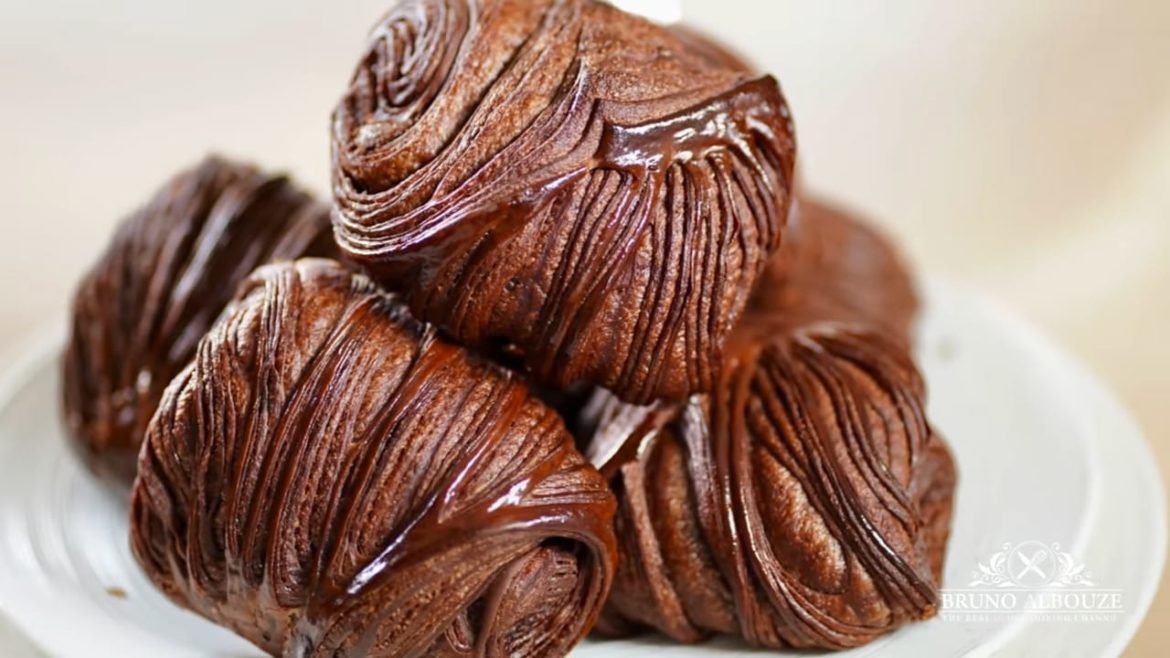The already famous Pain Au Chocolat or Chocolatine has reached its new level of perfection.
Recipe inspired by Guillaume Cabrol the head baker of the Plaza Athénée in Paris. This (tout chocolat) updated version is without any doubt the best ever made to date.
Make 2 or 3 days ahead.
Yield 14. 2.8 oz (80/90g each) + 0.7 oz / 24g Chocolate Hazenut Bars.
Cocoa Nibs-Milk Infused
- 100g Cocoa nibs
- 450g Milk, chilled.
- Use milk or water only if cocoa nibs aren’t available. Toast cocoa nibs in the oven for 5 min at 350ºF.
- Throw cocoa nibs in milk and blend well. Sieve and readjust liquid weight by adding more milk if missing (425g is needed for the dough).
- Save cocoa nibs for snacks; excellent mixed in yogurt…
Chocolate Croissant Dough TTF 56ºC
- 250g Bread flour
- 250g All-purpose flour
- 50g Cocoa powder
- 15g Instant yeast, or 30g fresh yeast
- 12g Salt
- 60g Sugar
- 15g Honey
- 80g Unsalted butter, cubed and room temp
- 425g Cocoa nibs infused milk, at 12ºC.
Butter Slab
250g unsalted butter, at room temp (Use the best Europen style butter available)
Make a 6’’x6’’/15x15cm butter slab between 2 parchment paper sheets and chill. Leave it out 15/20 minutes prior folding.
- European-style butter are favored for their rich taste and saturated yellow hue — a direct result of the higher butterfat content (+82%) and less water.
- Follow the same protocol whether mixing by hand or using a stand mixer fitted with the hook attachment.
- Combine all ingredients together, then add cocoa nibs infused milk. Transfer dough onto a clean work surface.
- Knead using the palm of your hand and smash dough until it becomes smoother and elastic; this should take 10 minutes.
- if using a stand mixer, mix on medium-high for about 7 min, or until the dough comes out the sides of the bowl.
- The internal temperature of the dough should be at 25C (DDT: desired dough temp).
- Place dough in a lightly oiled container; not too large but rather twice the size of the dough.
- Cover and let ferment for 2 hours or until doubled in size.
- Turn out onto a work surface (no extra flour needed), and deflate dough completely.
- Fold sides over, and shape into a tight oval form, flatten and freeze 20 min on each side uncovered or just the top – keep refrigerated until ready to laminate.
- The dough can also be stored in the refrigerator overnight.
- Meanwhile, leave butter slab out for about 20 min; it should be at the same consistency as the dough; firm but workable.
Praliné (Hazelnut Spread)
- 100g Whole hazelnuts
- 100g Whole almonds
- 200g Sugar
- 1g Salt
- 10g Cocoa butter, or butter.
- Toast nuts for about 10 min in a 350ºF/190ºC oven. In a hot saucepan, turn sugar into caramel.
- Add toasted nuts in caramel along with salt and cocoa butter. Coat well and transfer onto a silicone baking mat.
- Let cool to room temperature, and break caramelized nuts into pieces.
- Thrown in running food processor gradually and blend until it turns into paste.
- It can be stored for months in a refrigerator. Praliné is one of the most used mixtures in pastry and confectionery.
Gianduja For Bars
- 200g Praliné
- 100g Milk chocolate
- 100g Dark chocolate (54/58%).
- Melt both chocolates together (just melted – do not overheat) and mix with praliné. Pour mixture in a small tray lined with parchment or plastic wrap and chill. Cut out into 12g bars / 2.4’’x0.4’’/6x1cm (2 per serving). Place in the freezer until ready to use.
- Folding Process / Lamination (Tourage). A double turn and one single turn gives 17 layers. Turn air-conditioning on if room temp exceeds 73.5ºF/23ºC.
- For the double turn (Tour double): Roll out dough into a ≈ 6×15 inch (14x35cm) rectangle (about twice the size of the butter slab).
- Place butter covering half of the surface of the dough, and fold over to enclose (do not overlap dough). Seal and roll out into a long and narrow strip ≈6’’x27’’/15x70cm keeping all edges as straight as possible.
- Begin rolling from the center of the dough towards the edges, and not from one side of the dough all the way to the other side. This technique helps to keep the dough at an even thickness. Always brush out any excess flour before folding.
- The left edge is folded in to meet the last third on the other side, then the right third is folded in then close like a book. Flatten; wrap up and refrigerate 30 min or for up to an hour to relax.
- For the single Turn (Tour simple): Roll out dough (seams set from noon to 6) into a 6’’x27’’/15x70cm rectangle, and fold like a business letter (if the dough resists chill it to rest 15 min more). Wrap up and let rest an hour.
- Roll dough (seams set from noon to 6) into a 13’’x24’’/33x50cm rectangle.
- The thickness of croissant dough should end up being around 0.20’’/ 4 to 5mm. Cut out 14 rectangles ≈ 6.3’’x2.75’’/16x7cm; save scraps.
- Arrange cuts onto a frozen baking tray and refrigerate to harden prior scoring – Score using a sharp pairing knife or use a razor blade.
- Flip and roll out with 2 Gianduja bars.
- Repeat until done and keep refrigerated for a day max or freeze croissants for 2 weeks max.
Egg Wash
- Blend 1 whole egg with a pinch of salt.
Baking:
- If using a conventional oven:
- Preheat oven to 400ºF/200ºC and bake croissants for about 24 minutes.
- If using a convection oven:
- Preheat oven to 375ºF/190ºC and bake for about 18 minutes.
*The TTF: Total Temperature Factor (Typo in the video displays as DDT), was determined by professional bakers to ensure consistent fermentation results no matter the season. It takes into consideration the temperature of the fournil, lab or kitchen, the temperature of the dry ingredients (mainly flour) and the friction factor according to the machine used. Then, the liquid temperature is adjusted in order. Most yeasty dough should end up with an internal temperature of 77ºF/25ºC (DDT: desired dough temp). This will ensure a proper fermentation process. It could end up being cooler as 72ºF/22ºC and the fermentation will take longer but it is less consequential than getting an internal temperature of 90ºF/30ºC. Indeed, if too warm the fermentation will speed up affecting the final results such as taste and color. At home though, the +6ºC seems to be pretty accurate wether using a stand mixer mixing on medium-high for 7 min or kneading by hand for 10 min.
TTF 56ºC
Room temperature: 22ºC
- Ingredients temperature: 22ºC
- Liquid temperature: 12ºC
= 56ºC.
Divide this number by 3 and add the friction factor (by hand or mixer): + 6ºC.
22ºC+22ºC+12ºC = 56ºC ÷ 3 = 18.6ºC + 6ºC = 24.5ºC (DDT: desired dough temp).
Recipe video
Enjoy
See also:


